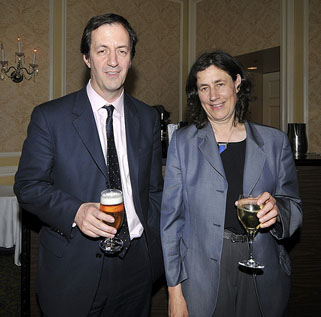Another miniature long-winded dissertation on why Canadian Senate reform remains crucial, despite all the arguments against it!
Jun 11th, 2011 | By Randall White | Category: In Brief
This “Photoshopped” Stop Harper sign in a shot of Prime Minister Harper at the third 2011 Stanley Cup game, in Boston, has already appeared on the net. It mimics Brigette DePape’s sign at the June 3 throne speech in Ottawa. And as Yahoo News Canada has suggested, it “seems unlikely to be the last.” It can perhaps also be read as a sign that the Canadian people just may finally compel their politicians to come up with some workable substantial change in the present unreformed Senate of Canada, at last.
Senate reform has been in the Canadian news again this past week. And – even with the new Harper Conservative majority in the elected “lower house” of Parliament –Â the sceptical bottom line is don’t hold your breath.
Jeffrey Simpson concluded his latest shot in this dark forest with: “The Senate can’t be unilaterally abolished – the smaller provinces with a larger number of seats than their population warrants would never stand for it. The Senate isn’t going to be elected – the larger provinces wouldn’t stand for it … A prime minister can tinker with the Senate, as Mr. Harper is doing … But more substantial change? It’s a great subject for university seminars and long-winded dissertations.”
Thursday night on the CBC National news the lovely Althia Raj also urged that the federal legislation encouraging provincial Senate elections which Mr. Harper still appears to be contemplating is unlikely to have great impact, since it won’t be offering any federal financial assistance to provincial governments. Like Mr. Simpson, she no doubt has a point.

Althia Raj is a National Political Reporter for Postmedia News. She’s “bilingual, bi-cultural and bi-medial ... She walks to work, drinks too much coffee, loves miniature food and Parliamentary procedure.”
In fact, I probably said too much on Ms. Raj’s point about federal financial assistance in an earlier miniature long-winded dissertation on this site, just over a year ago, headlined “Three strikes and you’re out .. Harper government not really driving Canadian Senate reform agenda now?” And I agreed with Mr. Simpson’s view that the whole subject of Canadian Senate reform “does often seem … hopeless” as long as almost half a dozen years ago, in another place.
Call me crazy (you certainly won’t be the first), but I nonetheless continue to hope for and support even the attenuated stab at federal legislation encouraging provincial Senate elections that Mr. Harper’s government (and its new democratic reform point man Tim Uppal) apparently still has in mind, as part of its latest step-by-step Senate reform plans.
(The other step – having “senators appointed to fixed terms, instead of the age limit of 75” – remains, as Jeffrey Simpson nicely puts it “a sensible change but not a terribly important one.”)
Why Harper’s step-by-step Senate reform is still worth supporting
My continuing support for the Harper government’s step-by-step Senate election reform hinges on two key reasons – one shorter and the other longer term.

Andrew Coyne and Chantal Hebert – CBC At Issue panellists who seem to disagree on many things, including Senate reform?
The first is that, as Andrew Coyne urged last night on the CBC National news, if Mr. Harper’s current plans to tinker with provincial Senate elections have any real impact at all, they will, slowly but surely, increase the pressure on both federal and provincial governments – and indeed ultimately even we the practically sovereign Canadian people – to finally dig into the quite serious question of “substantial change” in the unreformed Senate of Canada.
My second reason is my steadily strengthening conviction that substantial change in a number of so-called “democratic reform” directions (where Senate reform qualifies as one key case in point) is going to prove crucial to Canada’s long-term survival. Over the next generation or so, Canada will have to either become what no less an authority than Conrad Black recently called “a serious country” or give up altogether (or, more exactly perhaps, become part of some new United States of North America?).
This second reason may be more difficult to see (to say nothing of appreciate) if you are sitting in the middle of the neo-Machiavellian morass of Canadian federal government and politics in Ottawa today – which now seems to have been deepened and enriched rather than transcended by Mr. Harper’s new Conservative revolution. But from where I sit (far away from Ottawa but less than 50 miles from the Canada-US border as the crow flies), the view is clearer.
An ultimate Senate reform design that might actually work

Alberta farmer Bert Brown (centre) was sworn into the Senate in October 2007. He is the second senator appointed after election as "senator-in-waiting" in Alberta. The Harper Government’s proposed Senate election reform would encourage other provinces to follow Alberta’s lead on provincial Senate elections.
Lest all this grow into far too long of a miniature long-winded dissertation, of the sort that Jeffrey Simpson and others hold in such no doubt deserved contempt, I want to conclude with just a few additional observations at this juncture, in the hope that they will help advance the debate a little further again.
All these observations, I should quickly note, are finally focused on answering the “quite serious question” (see above) of just what “substantial change” in the unreformed Senate of Canada in the longer term might involve.
My first observation is that Western Canada (and especially Alberta) began the modern quest for substantial change in the unreformed Senate of Canada back in the 1980s, but it is not going to finish it. (A sceptic would hasten to add ‘if it ever is going to be finished.’ We already have, however, too many sceptics of this sort in my view. I want to remain a believer by choice.)

For some reason, this photo of one famous Canadian appeared in Randall White’s article of last year on “Three strikes and you’re out .. Harper government not really driving Canadian Senate reform agenda now?”
Similarly, the Harper Government (a name Mr. Harper is apparently no longer insisting on) has, so to speak, inherited the modern Western Canadian quest. Yet (as we have now come to understand) it has limited mere “tinkering” practical ambitions at best. And so my earlier miniature long-winded dissertation on this site, just over a year ago, raised the poignant question “Harper government not really driving Canadian Senate reform agenda now?”
Second, in another related piece, from just the week before the week that is ending now, I pointed to the potential irony of an ultimately quite different regional finish in the modern quest for substantial change in the unreformed Senate of Canada. I hope the main thrust of my argument here was at least hinted at in the headline: “One dim light in the dark forest of Canadian Senate reform .. at least Jean Charest’s Quebec is NOT ‘objecting to modernizing the Senate’?”
To elaborate briefly, I argued in this most recent miniature long-winded dissertation that enhanced representation for less populous regions in the central institutions of the federal government remains the key objective in the modern quest for Canadian Senate reform. But the concept of “equal” provincial representation in Alberta’s original Triple E concept (also the formula at work in the current Senates of both the United States and Australia) does not finally fit Canada’s more unique circumstances.
Very quickly, what we need for a workable long-term concept of Canadian Senate reform is a “reformed Senate concept of provincial representation which makes sense for Quebec – as well as the other demographically large provinces of Canada.” (And an added attraction of such a concept is its potential for helping to entrench the founding Canadian commitment to the survival and vigor of the French-speaking majority in Quebec.)
What I failed to do in my most recent miniature long-winded dissertation (I have come to realize in discussing it briefly with some congenial colleagues over congenial beverages) is spell out some more exact Senate reform design for a long-term Canadian provincial representation concept that meets these requirements and might actually work. I left that job to some embedded links to other articles. But this was a mistake.
So … as my penultimate observation here today I want to just spell out an example of a long-term Canadian provincial (and related) representation concept that might actually work, without further comment at this juncture. (For a bit more detail on how the following numbers were derived, if you actually are interested, see this earlier article.)
Here it is: Quebec 12 seats, Alberta 6 seats, British Columbia 6 seats, Ontario 6 seats, Manitoba 3 seats, New Brunswick 3 seats, Newfoundland and Labrador 3 seats, Nova Scotia 3 seats, Prince Edward Island 3 seats, and Saskatchewan 3 seats – and (as at present) one seat for each of the three territories.
 You can say this is pie in the sky and much worse, of course, of course. And, of course as well, the scepticism of Jeffrey Simpson and others on any prospect for “substantial change” in the present unreformed Senate of Canada does make a lot of sense, from some Canadian traditionalist perspective. I just don’t think myself, however, that any such perspective is going to prove strong enough for the future.
You can say this is pie in the sky and much worse, of course, of course. And, of course as well, the scepticism of Jeffrey Simpson and others on any prospect for “substantial change” in the present unreformed Senate of Canada does make a lot of sense, from some Canadian traditionalist perspective. I just don’t think myself, however, that any such perspective is going to prove strong enough for the future.
If we cannot finally come up with some kind of workable concept of “substantial change” in the present unreformed Senate of Canada, we are not going to be able to do a lot of other things that we are going to have to do if an independent “real country” of Canada is going to survive the increasingly tough challenges of the 21st century either! And such key current headlines as “Photoshopped ‘Stop Harper’ sign at Stanley Cup finals signals birth of a meme” suggest to me that it would be wrong to give up on all hope for the Canadian long-term future just yet.


